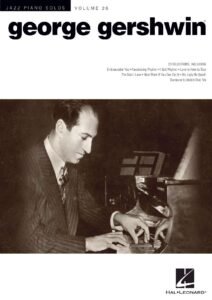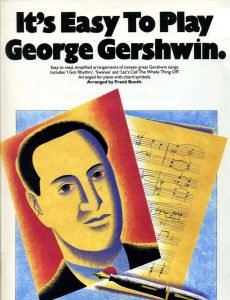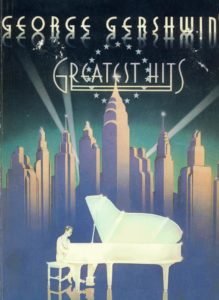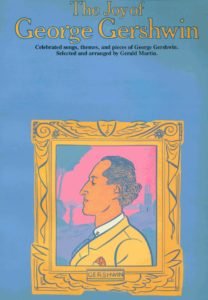Table of Contents:
George Gershwin (sheet music in the #smlpdf)

Best Sheet Music download from our Library.
George Gershwin – Rialto Ripples
George Gershwin – American in Paris Songbook, An – A New Musical( sheet music)
George Gershwin – Greatest Hits (Book), including the songs:
- Bidin’ My Time
- But Not For Me
- Embraceable You
- A Foggy Day
- I Got Plenty O Nuttin
- I Got Rhythm
- It Ain’t Necessarily So
- I’Ve Got A Crush On You
- Let’s Call The Whole Thing Off
- Liza
- Love Is Here To Stay
- Love Is Sweeping The Country
- The Man I Love
- Maybe
- Of Thee I Sing
- Oh Lady Be Good
- Rhapsody In Blue
- Somebody Loves Me
- Someone To Watch Over Me
- Strike Up The Band
- Summertime
- Swanee
- S Wonderful
- They All Laughed
- They Can’t Take That Away From Me
- Who Cares
George Gershwin – I Got Plenty O Nuttin
George Gershwin – I Loves You Porgy
George Gershwin – It’s Easy To Play George Gershwin, including:
- A Foggy Day
- But Not For Me
- Embraceable You
- Fascinating Rhythm
- I Got Rhythm
- I’Ll Build A Stairway To Paradise
- Let’s Call The Whole Thing Off
- Nice Work If You Can Get It
- Oh Lady Be Good
- Somebody Loves Me
- Someone To Watch Over Me
- Summertime
- Swanee
- S’Wonderful
- They All Laughed
- They Can’t Take That Away From Me
George Gershwin – Own Transcriptions Do It Again (piano solo)
George Gershwin – Prelude No. 1 arr. for Guitar with TABs
George Gershwin – Prelude No. 2 arr. for Guitar with TABs
George Gershwin – Prelude No. 3 arr. for Guitar with TABs
George Gershwin – Summertime (Piano, Vocal, Guitar chords)
George Gershwin – Summertime (Solo – Miles Davis)
George Gershwin – Summertime Arr. For Guitar solo
George Gershwin – The Greatest Songs Of George Gershwin, contents:
1. The Real American Folk Song
2. Bess You Is My Woman
3. I Got Plenty O’ Nuttin
4. It Ain’t Necessarily So
5. My Man’s Gone Now
6. Oh Bess, Oh Where’s My Bess
7. Summertime
8. There’s A Boat Dat’s Leavin’ Soon For New York
9. A Woman Is A Sometime Thing
10. Just Another Rhumba
11. Slap That Bass
12. (I’ve Got) Beginner’s Luck
13. Let’s Call The Whole Thing Off
14. Promenade (Piano Solo)
15. Shall We Dance
16. They All Laughed
17. A Foggy Day
18. I Can’t be Bothered Now
19. The Jolly Tar and The Milk Maid
20. Nice Work If You Can Get It
21. I Love To Rhyme
22. I was Doing All Right
23. Love Is Here To Stay
24. Love Walked In
25. The Back Bay Polka
26. For You, For Me, For Evermore
27. They Can’t Take That Away From me
28. By Strauss
29. Sophia
30. All The Livelong Day (And the long, long night)
George Gershwin Jazz Piano Solos Series Volume 26 (George Gershwin), contents:
- Bidin’ My Time
- But Not For Me
- Embraceable You
- Fascinating Rhythm
- A Foggy Day (In London Town)
- How Long Has This Been Going On?
- I Got Plenty O’Nuttin’
- I Got Rhythm
- I Loves You, Porgy
- I’ve Got A Crush On You
- It Ain’t Necessarily So
- Let’s Call the Whole Thing Off
- Love Is Here to Stay
- Love Walked In
- The Man I Love
- Nice Work If You Can Get It
- Oh, Lady Be Good!
- ‘S Wonderful
- Somebody Loves Me
- Someone to Watch Over Me
- Summertime
- They All Laughed
- They Can’t Take That Away from Me
George Gershwin – The Life And Music Of (book by David Ewen) 1956
George Gershwin – The Memory Of All That The Life of George Gershwin (book by Joan Peyser)
George Gershwin – Will Donaldson – Rialto Ripples (Ragtime – Rag)
George Gershwin -The Gershwin Style (New Looks at the Music of George Gershwin) Book by Wayne Schneider
George Gershwin A Foggy Day
George Gershwin An Intimate Portrait by Walter Rimler (Book)
George Gershwin and Oscar Peterson Recueil Jazz Compositions Collection
George Gershwin His Life And Work by Howard Pollack (Book)
George Gershwin Jazz Songs Sheet Music, including:
Fascinating Rhythm …………………………………… 7
The Man I Love ………………………………………… 9
Oh, Lady, Be Good …………………..………………. 11 .
Someone To Watch Over Me ……………………… 14
‘S Wonderful ……………………………………………. 16
Strike Up The Band ………………………………….. 19
Soon ………………………………………………………. 22
But Not For Me ……………………………………….. 25
Embraceable You ….. ……………….. 28
I Got Rhythm ………………………………………….. 31
A Foggy Day (ln London Town) ……………….. 34
Nice Work If You Can Get It …………………….. 36
Love Walked In ……………………………………….. 38
Somebody Loves Me ………………………………… 40
Summertime …………………………………………….. 42
George Gershwin Summertime
George Gershwin That Certain Feeling
George Gershwin The Complete Gershwin Preludes Book
Gershwin Impromptu In Two Keys
Gershwin A Foggy Day – Jazz Masters Play Gershwin(Guitar with Tablature)
Gershwin – 3 Preludes piano
Gershwin – Limehouse Nights
Gershwin – Medley From The George White Scandals Of 1921 (with lyrics)
Gershwin – Meet Gershwin At The Piano (Book), contents:
- Love Walked In
- I Was Doing All Right
- Love Is Here To Stay
- Nice Work If You Can Get It
- Summertime
- I Got Plenty O Nuttin
- They Can’t Take That Away From Me
- Let’s Call The Whole Thing Off
- They All Laughed
- A Foggy Day
Gershwin – Own Transcriptions for the piano
Gershwin – Rhapsody In Blue 2 Pianos
Gershwin – Rhapsody In Blue (Solo Piano)
Gershwin – S Wonderful S Marvelous S Gershwin
Gershwin – Stone – 3 Preludes for 2 pianos four hands
Gershwin – Summertime Piano Solo
Gershwin – Summertime (original)
Gershwin – Summertime
Gershwin – That certain Feeling (sheet music)
Gershwin – The glory of Gershwin.[piano vocal chords]
Gershwin 12 Arrangements For Classic Guitar By John W Duarte
Gershwin An american in Paris
Gershwin Do Do Do (Piano Solo)
Gershwin Experiment David Cope Prelude
Gershwin Guitar Songbook taught by Fred Sokolow with Tablature, George and Ira Gershwin’s beautiful songs are timeless jazz standards, and they sound great on guitar. In this DVD Fred Sokolow plays & teaches six complete Gershwin arrangements, including:
They Can’t Take That Away From Me……………………………………………… 3
Solo ………………………………………………………………………………………………………….. 8
Nice Work If You Can Get It …………………………………………………………. 12
Solo ……………………………………………………………………………………………………….. 16
Our Love Is Here To Stay………………………………………………………………. 19
Solo ……………………………………………………………………………………………………….. 23
Oh! Lady Be Good ………………………………………………………………………… 26
Solo ……………………………………………………………………………………………………….. 31
Someone To Watch Over Me ………………………………………………………… 34
Solo ……………………………………………………………………………………………………….. 39
A Foggy Day …………………………………………………………………………………. 43
Solo ……………………………………………………………………………………………………….. 48
Gershwin it ain’t necessarily so
Gershwin Jazz Interpretations
Gershwin Porgy And Bess Selection (Voice & Piano)
Gershwin Rhapsody In Blue (Piano Solo Arr.)
Gershwin Song Book – gershwin at the keyboard (Piano Solo), contents:
- ‘s Wonderful
- Clap Yo’ Hands
- Do Do Do
- Do It Again
- Fascinating Rhythm
- I Got Rhythm
- I’Ll Build A Stairway To Paradise
- Liza
- My One And Only
- Nobody But You
- Oh Lady Be Good
- Somebody Loves Me
- Strike Up The Band
- Swanee
- Sweet And Low Down
- That Certain Feeling
- The Man I Love
- Who Cares
Gershwin Summertime
Gershwin The Man I Love
Gershwin’s Melodies By Yuri Markin For 4 Hands Piano
Gershwin, George The Man I Love (Piano Solo Arr. By Percy Grainger) Sheet Music
Gershwin, George – Porgy and Bess
Gershwin, George I Got Rhythm Variations for piano and orchestra (Piano Score)
Gerswhin_Jeff Manookian Concert Paraphrase on I love you Porgy
Please, subscribe to our Library. Thank you!

The Best of Gershwin
The Best of Gershwin
Tracklist:
0:00:00 The Man I Love Carlo Balzaretti 0:02:04 An American in Paris 0:21:22 Concerto in F: I. Allegro 0:34:44 Concerto in F: II. Adagio – Andante con moto 0:46:12 Concerto in F: III. Allegro agitato Budapest Scoring Symphonic Orchestra, Peter Illenyi 0:53:03 3 Preludes: No. 2, Andante con moto e poco rubato (Arr. Naughtin) Metamorphose String Orchestra, Pavel Lyubomudrov 0:57:07 Rhapsody in Blue Budapest Scoring Symphonic Orchestra, Peter Illenyi 1:14:08 3 Preludes: No. 1, Allegro ben ritmato e deciso 1:15:39 3 Preludes: No. 2, Andante con moto e poco rubato 1:19:08 3 Preludes: No. 3, Allegro ben ritmato e deciso Luke Faulkner 1:20:22 Lullaby (Arr. for Piano) Harrison Sheckler

George Gershwin (short bio)

(Jacob Gershvin; Brooklyn, United States, 1898 – Beverly Hills, id., 1937) American composer. In a country that, until the end of the First World War , had depended in the musical field almost exclusively on fashions, composers and performers from Europe, George Gershwin was the first to make an unequivocally native voice heard, although capable, at the same time, to achieve success outside the borders of his homeland. And he did so through works in which elements from jazz and the classical tradition were skillfully synthesized, and which allowed him to stand out equally in fields as disparate as symphonic and popular music.
Please, subscribe to our Library. Thank you!
Son of a family of Russian immigrants of Jewish origin, his talent for music manifested itself at an early age, when, through voluntary self-taught, he learned to play the piano by ear. Given his enthusiasm, his father decided to make him study seriously with a teacher, Charles Hambitzer, who discovered the sound world of composers such as Liszt , Chopin and Debussy . However, Gershwin’s great references in those early years were Irving Berlin and Jerome Kern, kings of Broadway at the time thanks to their songs and musical comedies. The desire to succeed as a composer in concert halls, although latent then, would not take shape until years later.
Thus, in 1914, he abandoned his studies to work in a music store where, sitting at the piano, he presented fashionable melodies to the public. He soon encouraged himself to compose his first songs, some of which achieved some popularity and, above all, earned him the opportunity to write his first musical for Broadway, La, la, Lucille . His immediate success meant the true beginning of his career as a composer. This was followed by other titles such as Lady Be Good , Oh Kay! , Funny Face , Girl Crazy and Of Thee I Sing , which helped cement his fame and make him an even more popular character than the ones Kern and Berlin admired.
Starting in the 1920s, he also began composing other works intended for concert halls. An important date in this sense was February 12, 1924, when he premiered his Rhapsody in Blue at the Aeolian Hall in New York , a piece for piano and orchestra in which some elements of jazz were synthesized in an original way, such as syncopation. , with others of classical origin. The work was controversial, especially because of that same mixture of “serious” and “light” styles that constitutes its essence, but in a short time it managed to gain a place in the repertoire of the best soloists and the most prominent orchestras.
Rhapsody in blue was the first serious work in which Gershwin abandoned the easy successes of operettas, cinema and music halls, and attempted to cover the rhythmic, instrumental and thematic characteristics of jazz with the wise modes of European music, which would be represented in this case by the symphonic poem by Richard Strauss . However, some of the emphasis and instrumental megalomania of the model has passed into the aforementioned American imitation, partly suffocating the freshness and sincerity of the jazz elements.
The “blue”, which is, as is known, a typical American expression that indicates sadness, nostalgia or melancholy, a characteristic feeling that infiltrates the noisy joviality, gave rise to a rhythm that Gershwin was inspired by when he wanted to celebrate, in his first composition of great success and serious aspirations, the intense and tumultuous life of the metropolises, the whirlwinds of busy crowds, the chaos of the great arteries bustling and pulsating under the merciless masses of skyscrapers, the dissatisfaction and repressed sadness of the individual lost in the middle of the crowd. Typically American phenomenon; The flower of feeling emerges tenuously and delicately from the arid soil of cement and asphalt in the geometric rigidity of modern life.
Musically, Rhapsody in blue is composed of several orders of elements: the piercing and shameless screams of a motley jazz instrumentation, attractive with the insignificance of its easy and clamorous joy; the anguished retreat into nostalgia for string instruments and saxophones; and beneath all this, the stubborn and frenetic rhythm of jazz, continuously pulsating like the gigantic body of the great city, like the trampling of the feet of the enormous busy crowd. Rhapsody in blue is not a light and burlesque work, as its spectacular and brilliant exterior might lead one to believe; In it is deeply felt and partially expressed the tragic contradiction of modern life in the great metropolises that are hurried, rigid and desiccated in their geometric constructions of cement and steel. A kind, in short, of musical Dos Passos , even for its naive fondness for sensational technical exteriority.
The success of Rhapsody in Blue did not make Gershwin forget his numerous technical gaps, so he continued his musical studies with the intention of enriching his style and addressing more ambitious goals. In 1925 another concertante composition arrived, the Piano Concerto in F , which was followed by the symphonic piece An American in Paris .
Premiered on December 13, 1928 in New York, An American in Paris is a colorful and brilliant score in which Gershwin attempted to describe the impressions of an American tourist while strolling through the French capital. And he did it with an enviable sense of humor, evident in some original instrumental resources, such as the surprising use of car horns or the quotation of melodies from a variety of sources. The orchestration is by Gershwin himself, and it features prominently the drums, as well as the four car horns acquired by the composer in an establishment located on Avenue de la Grand’Armée . Cinema, led by director Vincente Minnelli and actor and dancer Gene Kelly , would contribute to the popularity of the piece.
The culmination of his career as a composer came in 1935 with the opera Porgy and Bess , in which the author, true to his style, synthesized the two traditions he knew: the American one, represented by jazz and the spiritual, and the European symphonic one. . Gershwin chose for his first and only opera (his premature death cut short the realization of new projects) a plot in which the life of a black community in the southern United States is described in a vivid and poetic way, specifically in the town of Charleston.
Its main protagonists are the invalid Porgy and Bess, a young woman with drug addiction problems. The conflict breaks out when Crown, her lover, kills a man during a game of dice and flees from her. When Bess seeks refuge next to Porgy, love is born between the two. Their happiness, however, will not be possible: Crown returns and Porgy is forced to kill him. With Porgy in jail, Bess will give in to the advances of Sporting Life, a drug dealer, to go to New York with him. When the invalid leaves prison and hears the news, he decides to leave in search of his beloved.
Composed on a libretto written by his brother Ira, his frequent collaborator, and Du Bose Heyward, on an original novel by the latter, Porgy and Bess is not only the title of the fundamental work of the American operatic repertoire, but it is also that of a of the most extraordinary operas of the 20th century. One of the most surprising characteristics of this opera is its author’s use of jazz (primarily associated with the character of Sporting Life) and African-American spirituals. In previous works Gershwin had distinguished himself by his ability to synthesize resources from these languages with the European classical tradition, but it is in his opera where this synthesis achieves its best results. Numbers like Summertime (one of the most universal songs in the entire American repertoire), Oh, I got plenty o’nuttin or Bess, you is my woman now are absolutely unforgettable. They are the ones who, together with some choral pages, make Porgy and Bess a unique and fascinating work.
The premiere of Porgy and Bess took place on September 30, 1935 in Boston, causing confusion among some critics due to its innovative use of formulas from jazz and African spirituals, two styles far removed from conventional opera. Despite this initial resistance from specialized critics, Porgy and Bess quickly established itself on stages around the world, to the point that today it is the American opera par excellence. George Gershwin, however, could not enjoy his success for a long time: a brain tumor prematurely cut short his life, depriving American music of one of its most representative and universal composers.
